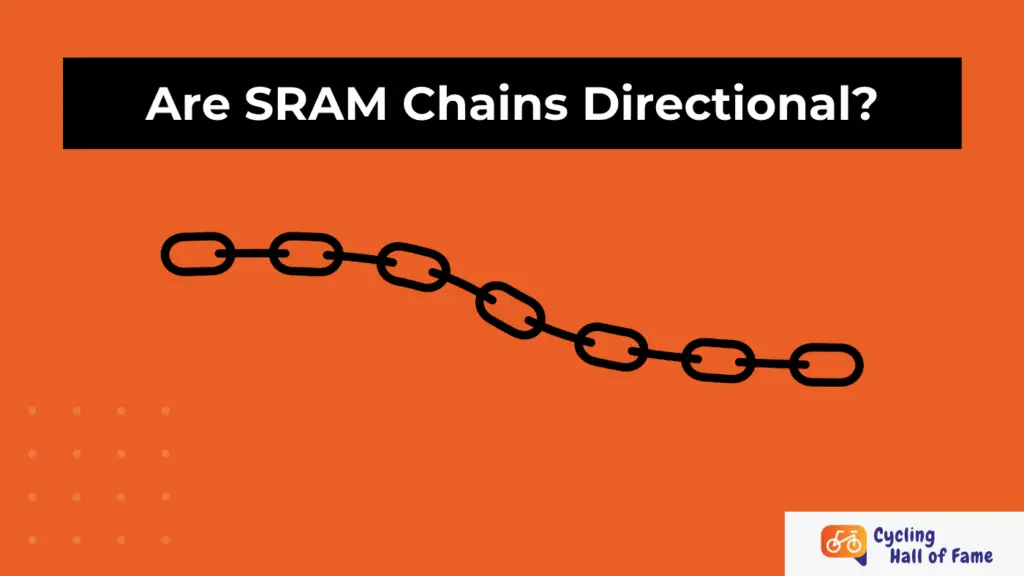An efficient bike ride largely depends on its chain’s functionality, the critical component that transfers power from the rider to the wheels.
This silent force behind every pedal stroke requires meticulous attention, especially regarding installation.
A common question arises with the variety of chains available, particularly concerning SRAM chains – are they directional? Is there a proper way to install them?
The answer may affect how you approach your next chain installation.
So, let’s delve deeper into this topic and enhance your bike maintenance knowledge.
Advertising links are marked with *. We receive a small commission on sales, nothing changes for you.
Key Takeaways

- SRAM chains are non-directional, allowing for flexible installation without worrying about orientation.
- Despite the chain’s non-directionality, the SRAM quick link is directional and should be installed so the arrow on its face points in the direction of chain travel.
- SRAM Eagle chains, while non-directional themselves, utilize directional master links that require correct orientation during installation.
- Post-installation checks ensure the chain moves smoothly over the gears and that the quick link and master link (if present) are correctly aligned and oriented.
- If unsure about any aspect of chain installation, consulting a bike maintenance professional or manufacturer’s guidelines can provide specific instructions and insights to ensure a smooth and efficient ride.
SRAM Chains
According to expert advice and various sources, SRAM chains are fundamentally non-directional. This denotes that they can be installed in any orientation on the bike without influencing its performance or causing any damage.
This non-directional feat also brings the cyclist a degree of convenience by allowing chain installation and replacement flexibility.
SRAM Quick Link
While the SRAM chains themselves do not have a prescribed direction, there is an element of directionality when it comes to the SRAM quick link. This quick link, often called a master link, is a component used to connect the chain ends.
An interesting fact about the SRAM quick link is that it is directional. This means it has an arrow engraved on its face, indicating the correct orientation.
Therefore, cyclists should ensure that the arrow points in the direction of chain travel while installing the SRAM quick link for the best results.
SRAM Eagle Chains
To expand our understanding of directionality in chains, we need to consider the SRAM Eagle chains. Even though the SRAM chains are non-directional, SRAM Eagle chains use a specific kind of master link that is directional.
This underlines that even if the chain is non-directional, certain elements within the setup may have a preferred direction and must be installed correctly.
Implications of Correct Installation
The non-directionality of most SRAM chains implies ease of installation. However, the existence of directional elements such as the SRAM quick link or specific master links used in SRAM Eagle chains makes it essential to ensure proper installation.
A misaligned quick link, for instance, can influence the smoothness of gear shifts and the bike’s overall performance.
Ensuring Proper SRAM Chain Installation
Now that we have established the non-directionality of SRAM chains and the directionality of some of their components, let’s explore how to ensure a proper installation process.
This will help ensure that your bike chain operates at maximum efficiency and durability.
Inspecting the SRAM Chain
Before beginning the installation process, inspecting the SRAM chain is essential. This will help identify any existing damages or manufacturing flaws that could impact the chain’s performance.
As noted earlier, SRAM chains are non-directional, so you needn’t worry about a specific orientation.
Attaching the SRAM Quick Link
While the chain doesn’t have a specific direction, it’s crucial to remember that the SRAM quick link does. This component must be installed so the arrow on its face points toward chain travel. So when you begin cycling, the arrow should move forward.
Dealing with SRAM Eagle Chains
The SRAM Eagle chains represent a slightly different scenario. Even though the chains themselves are non-directional, the master links they use are directional.
Therefore, if you have an SRAM Eagle chain, you must ensure the master link is correctly installed.
Checking Post-Installation
Once you’ve attached the chain and the quick link correctly, checking the entire setup post-installation is essential. You’ll want to ensure the chain moves smoothly over the gears, the quick link is correctly aligned, and the master link (if present) is properly oriented.
Conclusion
In conclusion, SRAM chain installation is relatively straightforward thanks to its non-directionality. However, certain components, like the quick link or the master links in SRAM Eagle chains, do require specific orientations.
Whether you’re a novice bike mechanic or a seasoned pro, knowing your bike’s components and how they work together can be crucial for keeping your ride smooth and enjoyable.
Ultimately, the best advice remains – consult a professional or refer to the manufacturer’s guidelines when in doubt. They can provide specific instructions and insights to help you navigate the process confidently.
Frequently Asked Questions.
Are all SRAM chains non-directional?
Yes, all SRAM chains are non-directional. Therefore, they can be installed in any orientation. However, the SRAM quick link is directional and connects the chain.
What does the directionality of a bike chain mean?
The directionality of a bike chain refers to a specific orientation in which a chain should be installed for optimal performance. Some chains are designed with different outer and inner plates, hence the need for directionality.
Are there any other directional bike chains besides SRAM Eagle chains?
Yes, some bike chains from other manufacturers, like Shimano, are directional. Always check the manufacturer’s instructions when installing a new chain.
How often should I replace my SRAM chain?
It depends on your riding conditions and maintenance routine. You should consider replacing your chain every 2,000 to 3,000 miles.
Advertising links are marked with *. We receive a small commission on sales, nothing changes for you.
